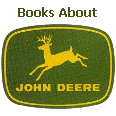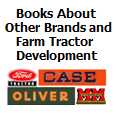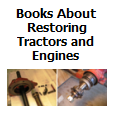| The Operation, Care,
and Repair of Farm Machinery. Deere and
Company. |
 |
 |
Published between 1927 and 1957 by John
Deere, these old vocational agriculture textbooks are still
excellent references for anyone interested in small farming.
The books provide detailed descriptions and black and white
photos of basic tractor maintenance, setting up a plow,
plowing a field, using and maintaining harrows, planters,
mowers, hay balers, combines, etc. All of the
equipment pictured is made by John Deere, but the concepts
and many of the details apply no matter what brand you have.
Early editions focus on horse-drawn equipment; later
editions on tractor-drawn equipment. My copies are of
the 27th (1955) and 28th (1957) editions.
A variety of editions are often available on
eBay. |
|
|
|
|
|
| |
|
| Successful Small-Scale
Farming, An Organic Approach. Karl Schwenke, 1991. |
|
|
Another excellent book for anyone new to small
farming, with clear and detailed descriptions of crops, equipment,
farming procedures, and more. Some of the material is similar to
parts of the Operation, Care, and Repair of Farm Machinery
series (above), but this book also touches on soil chemistry, soil
conservation, plant biology, marketing crops, managing a woodlot, etc. |
|
|
|
| The American Family
Farm. Hans Halberstadt, 2003. |
|
|
Sentimental and historical
look at farm life, organized by season, with good descriptions of
a lot of basic farm tasks—plowing, planting, threshing, etc—and many
first-person anecdotes from people who've grown up on farms, including
some brief quotes from my father. New color photos and many
vintage black and white ones illustrate the story, but in some
cases don’t seem to add much. This is a nice coffee-table browsing
book—if you need a how-to book, several of the other books on this page
would be better choices. |
|
|
|
| |
|
|
The Contrary Farmer.
Gene Logsdon, 1995. |
|
|
A genuinely enjoyable and thought-provoking look at
living a more pastoral life, with lots of concepts that would work as
well in my suburban back yard as they would on the farm I hope to have
in the future. As much philosophy as how-to, although there are
quite a few simple and practical suggestions that could help any
"cottage farmer," whether you're working on a tiny garden bed in the
yard or on a hundred acres. |
|
|
|
| Five Acres and
Independence: A Handbook for Small Farm Management. Maurice G.
Kains. |
|
|
Some sections of this 1940 book aren't as relevant as
they used to be, but a lot of it still makes good sense and applies to
small-farm life today. I particularly enjoyed the chapters related
to understanding and caring for soils and various plants--there's some
practical science there that's well worth not having to learn the hard
way. |
|
|
|
| |
|
| Forty Acres and a
Fool; From Tinkering to Torquing - A Beginners Guide to
Tractors and Tools. Roger Welsch, various
publication dates. |
|
|
|
Part philosophy, part practical guide,
these books are sort of like an advice column for moving to
the country and working on old tractors, aimed at folks who
didn't grow up with those experiences. Roger offers
some useful food for thought, and his humor shows itself now
and then, but as with any other advice column I'd caution
readers to use their own judgment before taking assertions
as facts.
|
|
|
|
|
| The American Barn by
Randy Leffingwell, 2003; and Barn: The Art of a
Working Building, by Endersby, Greenwood, and Larkin,
1992. |
|
|
|
These two similar books, by different
authors, each provide a beautiful look at barn history,
styles, an Amish barn-raising, and more. Both are
thoroughly researched, flawlessly written, beautifully
photographed. The American Barn was
originally published in
hardcover in 1997. |
|
|
|
|
|
|
|
| Old Tractors and the
Men Who Love Them; Busted Tractors and Rusty Knuckles; Love,
Sex, and Tractors. Roger Welsch, various
publication dates. |
|
Roger Welsch takes a fun look at the old
tractor business in these and other books, recounting his
adventures in learning about and rebuilding old machines
while simultaneously navigating other aspects of life.
His observations include nuggets like "Old tractors are good tractors
because
they have only forty-six parts," and "You don't pound on old tractors. You beat
on old tractors." My favorite is The Magneto
Principle: "Certainly one thing women and tractors
have in common is whatever it is that makes magnetos work.
When they work. Thing is, no one knows what makes
magnetos work."
Roger seems to play well the
part of a curmudgeon, but in addition to liking these old machines and
writing funny books about them, he goes to places like Greenland and
Bosnia to
offer a bit of Midwest Americana to GIs far from home.
Doesn't
get rich doing it but goes anyway. Thanks, Roger.
More
on Ol' Rog. |
|
|
|
|
|
|
|
|
| |
|
| This Old Tractor; This
Old Farm; 100 Years of Vintage Farm Tractors.
Edited by Michael Dregni; various publication dates. |
|
|
|
|
These books are beautifully illustrated collections of
nostalgic and entertaining essays about farming, threshing,
old machines, rural themes, and so on. Each includes
about 15 essays, some from authors with names I recognized (C.H.
Wendel, E.B. White, Don MacMillan, Roger Welsch, Randy
Leffingwell, Garrison Keillor, Ralph Sanders, Robert Pripps,
Bob Feller) and some not, some written recently, some not.
Many great vintage and recent photos, and a sprinkling of
classic illustrations such as the paintings Walter Haskell
Hinton created for Deere and Company. |
|
|
|
|
|
| |
|











